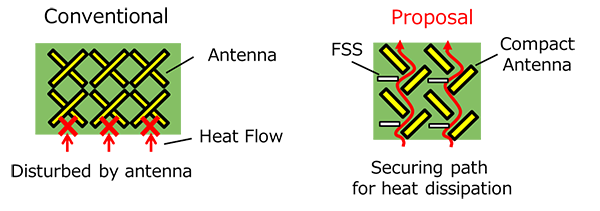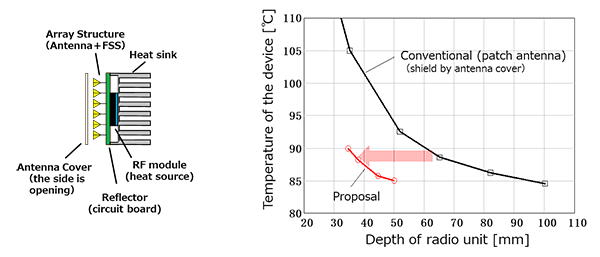NEC develops antenna heat dissipation technology enabling compact 5G-compatible radio units
Doubling heat dissipation performance and halving unit size
Tokyo, September 20, 2018 - NEC Corporation (NEC; TSE:6701) announced today the development of an antenna heat dissipation technology that enables the size of radio units to be reduced through the use of a massive-element antenna, aiming for practical application of 5G next-generation wireless communication standards. By combining heat dissipation from an antenna with the conventional heat dissipation from a heatsink, NEC has achieved heat dissipation performance of about twice that of a conventional configuration. This corresponds to reducing the volume of a radio unit to about half.
With the introduction of 5G, large-capacity communications that utilize beamforming with massive-element antennas are expected. However, since the internal temperature of the unit increases with the rising power consumption of the wireless circuit for each antenna, the volume of a heat dissipation mechanism, called a heatsink, will become larger, resulting in a bigger unit. This restricts the potential locations where the radio units can be installed.
The antenna heat dissipation technology NEC has just developed is achieved by combining (1) the addition of a heat dissipation function to an antenna (this function is not conventionally included), and (2) the design of air flow paths that improve heat dissipation efficiency. This enables reductions in both the size and weight of the radio units, improving installation flexibility. In addition, since this unit does not require a heat dissipation fan and can remain quiet, it can also be provided for indoor environments such as airports and shopping malls.
"NEC focuses on ‘Solutions for Society' and actively performs research & development aiming to realize 5G," said Soichi Tsumura, General Manager, System Platform Research Laboratories, NEC Corporation. "We will continue to promote technological development that reduces the size of radio units and contributes to the early establishment and deployment of 5G mobile networks."
NEC's new heat dissipation technology includes the following features:
- Addition of a heat dissipation function to antennas (this function is not conventionally included) In conventional radio units, the antenna and heat dissipation functions were designed separately, which means that heat was dissipated from the heatsink attached on the back of the antenna, not from the antenna surface. With this new development, NEC has made the antenna surface function as a heat dissipation fin with a uniquely shaped metal surface for the antenna elements and designed an additional metal plate with a Frequency-Selective Surface (FSS) structure, which becomes transparent at certain radio frequencies, as a heat dissipation mechanism to enable heat dissipation from the antenna surface, which allows heat dissipation from both the antenna and heatsink.
- Securing air flow paths that improve heat dissipation efficiency To efficiently dissipate heat from the antenna surface, it is necessary to secure flow paths for the air containing heat between the antenna elements, which work as heat dissipation fins for conveying heat from the circuits. Because conventional antenna elements were large, it was difficult to secure the air flow paths. Therefore, NEC has used antennas with a split-ring structure (Note 1), to achieve about half the size of a general patch antenna. Moreover, by holding them in an upright position and arranging them like checkered plates, NEC has formed flow paths for the air containing heat and realized heat dissipation from the antenna surface. In addition, NEC has placed the metal plate with the FSS structure so as not to block the air flow paths. Consequently, NEC has increased the density of heat dissipation fins to maintain the communication properties of the antenna and improve the heat dissipation efficiency.

Fig. 1 Images of a massive-element antenna configuration and formation of heat dissipation paths
Simulations of the heat dissipation performance of a radio unit that uses NEC's recently developed antenna heat dissipation technology (Note 2) confirmed that heat dissipation performance per unit volume is approximately twice that of a conventional antenna configuration (Fig. 2).

Fig. 2 Heat dissipation performance in thermal simulation
Notes:
- *1) Antenna with a split-ring structure: Press Release (March 19, 2012)
"NEC Develops One of the World's Smallest Antennas Using Metamaterial Components for Improving Wireless Module Communications Performance" URL: https://www.nec.com/en/press/201203/global_20120319_02.html - *2) In the simulation of a radio unit, we assumed a configuration consisting of one printed circuit board an antenna array at the front of the unit, and a heatsink at the rear of the unit. We used a 35W multichip module on the rear of the printed circuit board as a heat source and set the wind speed to 1m/s.
Email Newsletters
Sign up to receive TelecomTV's top news and videos, plus exclusive subscriber-only content direct to your inbox.



